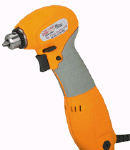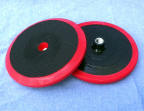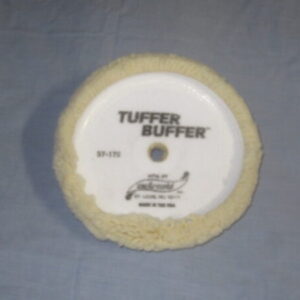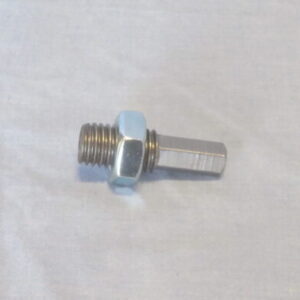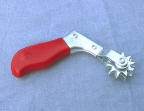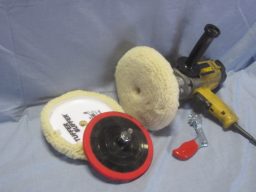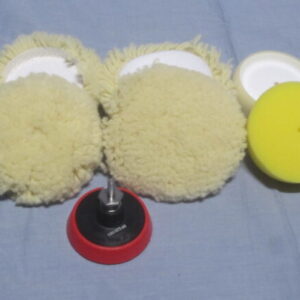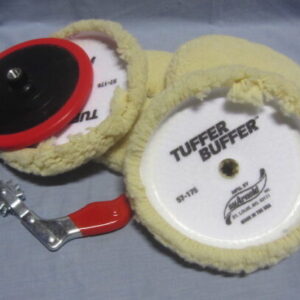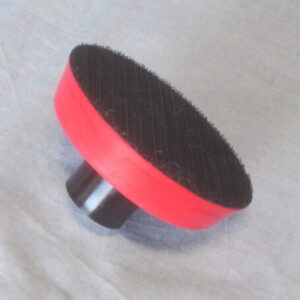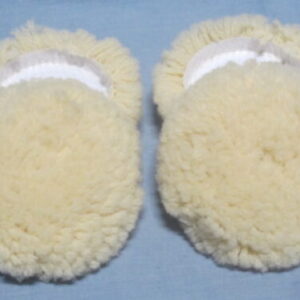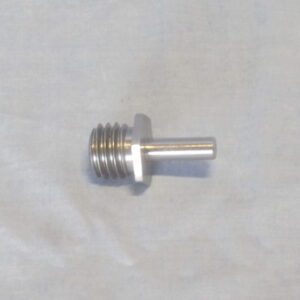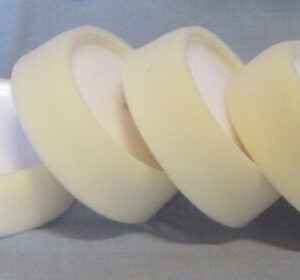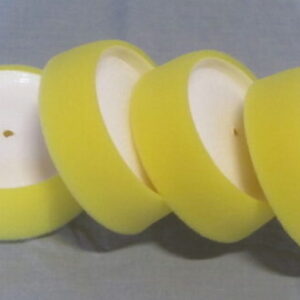Compounding Polisher
The Compounding polisher is used on new aluminum that has never been polished and on old aluminum that is corroded or damaged. The compounding polisher simply concentrates a lot of horsepower in a small area. If properly used it can do some pretty amazing things.
Even new aluminum fresh from the mill generally needs to be compounded before using the Cyclo polisher if a true mirror finish is to be achieved. The mill finish must be “reformed” via compounding or the final shine will likely be frosty.
Drill Type Compounding Polisher
Compounding removes surface corrosion but it does not remove base metal. Once the loose corrosion is removed the polisher just moves the base metal around and reforms the surface so that it can be highly polished. Nuvite calls it “healing the surface”. In the metal working trade it is called burnishing. When the compounding is done, the surface will be highly polished but the rotary motion of the polisher will have left swirl marks that must be removed with a random-orbit polisher such as the Cyclo polisher.
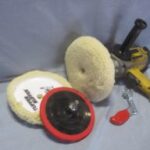
Car Polisher Type Compounding Polisher
There are two basic types of Compounding car polishers. One uses a standard 1/2 inch slow speed drill and the other uses a right-angle polisher/buffer intended for automotive detailing. Both use the same compounding pads and backup plates. The polishing pad is held in place on the backing plate via Velcro-type hook and loop system. The pistol-grip item is a pad cleaning tool described in Pads & Accessories below.
Car Polisher Type: This type of compounding polisher is the most widely used. Makita, DeWalt, Porter-Cable and Milwaukee make this type of polisher.
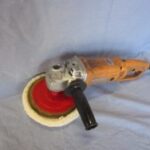
Be sure your polisher has a speed control that will allow it to be slowed down to 1000 RPM. Speeds over 1500 RPM should not be used because the aluminum will get overheated.
More details on how to use this polisher can be found on the Using the Compounding Polisher page.
Drill Type: The drill-based polishers have the advantage of high torque at low speed. The drill shown above is a 1/2 inch variable speed reversing DeWalt Model DW130 that turns at about 450 RPM. That drill is vintage 1990 but the current DeWalt is Model DWD216G which is variable speed. The slow speed means that it can be dragged slowly across the damaged area without overheating the aluminum. The right-angle car polishers turn at 1000 RPM or higher and must be moved a bit faster across the aluminum to avoid overheating the aluminum.
A disadvantage of the drill-type is that an adapter is needed to connect the drill chuck to the 5/8″-11 threads on the backing plate. We offer this adapter below.
Be sure that the drill you pick has handles near the front of the drill like the DeWalt shown above. The closer the handles are to the chuck, the easier it is to control. Do not use a drill with a pistol-type handle at the back. This type of drill is very hard to control and very hard on the wrist joint.
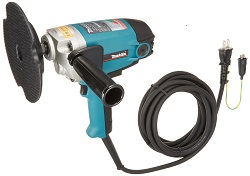 The drill type works best from knee-high to shoulder high because you can “lean into it”. The car buffer works better where you have to reach out, such as on the roof. Having both types of polishers will speed the work, but if you’re only buying one polisher, then get the car buffer.
The drill type works best from knee-high to shoulder high because you can “lean into it”. The car buffer works better where you have to reach out, such as on the roof. Having both types of polishers will speed the work, but if you’re only buying one polisher, then get the car buffer.
Makita PV7001C: The Makita PV7001C shown opposite is a variation of the drill type polisher. It does not have a drill chuck but instead has the standard 5/8″-11 spindle which allows the backing plate to be installed directly on the polisher. This brings the backing plate much closer to the side handle which provides greater control and comfort. This is probably best tool for compound polishing. A disadvantage is that can’t be used as a drill when your project is complete. It sells for about $200 on Amazon.
Pads: Both the drill-type and the auto buffer-type use the same compounding pads. The pads are about 10″ in diameter and the backing plate is 7.5″ in diameter. The pads are attached to the backing plate via a Velcro-type “hook and loop” system. The backing plate has 5/8″-11 female threads that mate directly to the auto-buffer drive spindle. An adapter, shown below, must be used to connect the back-up pad to the 1/2″ drill chuck.
Be sure the pad you use is 100% wool. Polyester pads are intended for working on paint. Compounding aluminum creates very high temperatures where the pad contacts the aluminum. Polyester pads may break down and leave tiny black dots of melted plastic on the aluminum. In contrast, polishing pads for aluminum are durable and reliable. If you’re looking for car polishing suppliers or polishing pad kits, start exploring our collection today.
Polisher, Pads and Accessories
Compounding Kits are offered below.
Prices include shipping
-
Backing Plate
$20.00 -
Compounding Pad
$15.00 -
Pad Cleaner
$11.00
Compounding Kits
The Basic Compounding Kit contains the essential items for compounding. The kit contains the following:
- (2) Compounding Pads
- (1) Backing Plate
- (1) Pad Cleaner
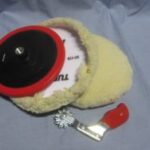
The Standard Compounding Kit contains two additional compounding pads. Pads need to be washed periodically and having a good supply of pads keeps the job moving. The kit contains the following:
- (4) Compounding Pads
- (1) Backing Plate
- (1) Pad Cleaner
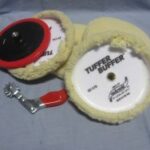
-
Basic Compounding Kit
$58.00 -
Small Compounding Kit
$53.00
Small Compounding and Polishing Pads
Polishing small or oddly shaped parts such as door frames or wheels can be done easily with the small wool and foam polishing pads shown opposite. The backing plate is 3″ diameter and uses the same “hook and loop” attachment method as the larger compounding pads. The wool pads are used for the initial compound polishing. The yellow pads (firm) and white pads (soft) are used to remove the swirls left by the wool pad and provide the finish polish.
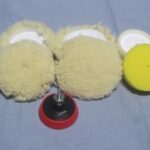
Two different wool pads are available. The 3″ pad is designed specifically for the 3′ backing plate. It has a dished-in backing that curves the wool up and over the backing plate allowing the pad to be used “on edge”.
The 4″ flat pad is designed to be used with the Cyclo polisher but works remarkable well with the 3″ backing plate. It has more dense wool than the 3″ pad and is preferred by many users.
When used with the Cyclo polisher the 4″ pad provides a very aggressive polishing medium. For example, it can be used in conjunction with the F7 grade of Nuvite to remove the swirls left by the compounding with F9 grade. When used with the Cyclo polisher the wool is used directly on the aluminum and the black foam pads and cotton fleece are not used.
The foam pads do a good job of removing the swirls left by the wool pad. The foam pads will leave a visible pattern on larger parts and flat surfaces but with small and oddly shaped parts the pattern is usually not visible.
The backing plate has 5/8-11 threads same as the large backing plate so an adapter is used to provide a 1/4″ spindle that will fit a drill chuck. Any small drill can be used. Keep the speed to around 1000 RPM. The items are available individually or as a kit.
Small Compounding Kit
The kit contains the following:
- 3″ backing plate
- Drill chuck adapter
- Two 3″ wool pads with curved lip
- Two 4″ flat wool pads
- yellow (firm) pad
- white (soft) pad
-
Standard Compounding Kit
$95.00
-
3″ Backing Plate
$10.00 -
3″ Wool Pad
$24.00 -
4″ Flat Wool Pad
$24.00 -
White Foam Pad
$18.00 -
Yellow Foam Pad
$18.00
Pneumatic Tools & Miscellaneous
If you have an air compressor available you might be interested in using these tools. The first is a pneumatic compounding polisher, Harbor Freight Tools Item 69583, about $70. It is not as powerful as the electric version but it’s lightweight and easy to handle. It has a 5/8-11″ spindle and takes the full-size backing plate and pads.
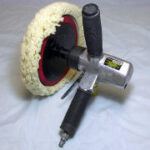
The second is a pneumatic right angle drill, Harbor Freight Tools Item 67474, about $50. This is our favorite tool to use with the small (3″) compounding and polishing pads.
A word about air compressors. Running either of these tools requires about a 5HP air compressor. The small compressors available for around $150 just don’t have enough horsepower to run either of these tools continuously. If your compressor plugs into a 15amp, 120volt outlet, it won’t be big enough to power either of these tools.
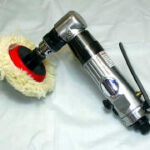
There are numerous electric right angle drills on the market. One of the lower priced ones is the Harbor Freight Item 60610, about $30. It works really well with the small 3″ pads, but a regular 3/8″ drill does a fine job too. A right angle drill is just a little more comfortable to use.
This drill really isn’t meant to be used for continuous duty. The motor gets hot in a hurry. But it should be fine for getting into those tight spots where the big pads don’t fit. Just let it cool down between uses.
